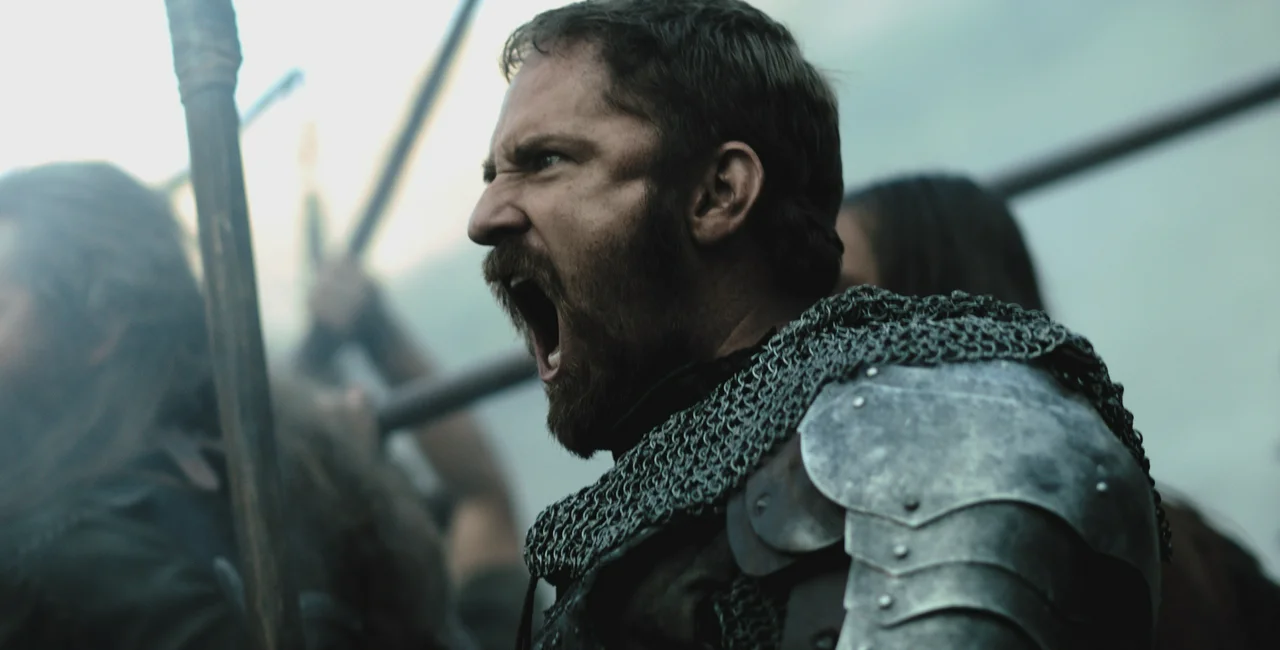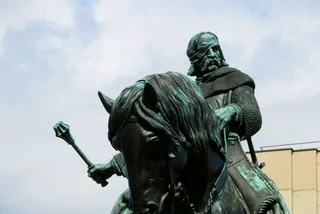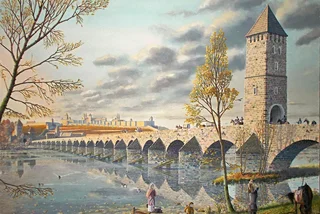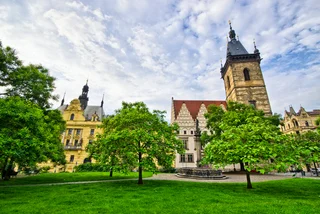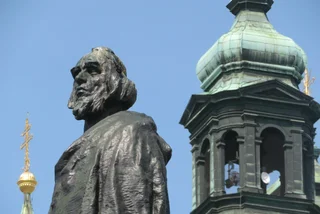The historical epic “Jan Žižka” – called “Medieval” outside Czechia – takes a brutal look at the early days of the national hero, played by American actor Ben Foster.
The film, the most expensive Czech production ever, was shot in English with an international cast to improve its chances on the world market. A Czech-dubbed version is being released locally, though the English version will have some screenings.
Some multiplexes as well as art house cinemas like Světozor, Bio Oko, Aero, and Lucerna are playing both versions. The English-language screenings should be billed in the schedule as “Eng,” “English friendly,” or “CZ titulky.” Avoid the screenings noted as “český dabing,” “česká verze,” or “ČV.”

Previous films about Žižka have concentrated on his later years in the Hussite Wars. This new version finds Žižka as the head of a band of ruthless mercenaries working for Lord Boreš, played by Michael Caine in one of his last roles before retirement. He did not come to Prague for the premiere, but the screen legend sent a video greeting saying he saw the film and was impressed with it.
This is no fairytale. The world of the early 1400s is colorless and endlessly muddy. People live in extreme poverty. The rich people have some fine clothes and jewels, but the castles seem cold, dim, and barren even at the best of times.

Torture is common, with military bands showing up in villages to root out rebels, and force reluctant men into service. The good guys aren’t much better, answering violence with more violence. The very people they want to protect often wind up getting caught in the middle.
There is a convoluted dispute over who will be Holy Roman Emperor, following Charles IV. His son Wenceslas IV (Karel Roden) is weak and ineffectual. His half-brother Zikmund (Matthew Goode) would rather have the crown.
Boreš comes up with a plan to kidnap Katherine (Sophie Lowe), the French fiancee of Henry of Rožmberk (Til Schweiger), to put pressure on Henry to support Wenceslas instead of Zikmund. For the rest of the film, she bounces between factions like a ping pong ball.

While Žižka and his band of mercenaries were alleged to have participated in kidnappings, the specifics of the plot are invented for drama. Katherine and Boreš, at least as seen in the film, are not historical figures.
Director Petr Jákl consulted with historians, but he was more concerned with the broad picture than with details. Little is known about Žižka’s early days, and much of that is disputed.

“I wanted to make a film that captures the mood of that era,” he said after a preview screening. “I wanted to make it as close as possible to the Middle Ages – the politics, how people felt,” he said. He also wanted to show religious reformer Jan Hus, even though Žižka was not yet a follower.
"The film is made for Czechs. It's a Czech thing, but I want people abroad to be able to say ‘They have a big story there,’” Jákl said.

Showing the overall feel of the era is where the film is most successful. Žižka’s band is a no-nonsense bunch, and the fighting is up close and fierce. We can see some of the tactics that Žižka is known for, including armored carts that seem to be forerunners of modern tanks.
While the teaser and first trailer concentrated on the plot, a second red-band trailer (meant to be shown only in front of R-rated films) was released last week and showed some of the more violent scenes.
In Medieval, Ben Foster is hired to kidnap a powerful lord's fiancée to prevent their rise to power. Check out the red band trailer here: pic.twitter.com/BpxkrNB71p
— IGN (@IGN) August 31, 2022
The film is least successful and least credible as a love story, though the filmmakers felt the need to include one. Sophie Lowe gives a compelling if understated performance, but the handful of romantic moments stick out against the otherwise relentlessly dark background.

Foster has a bit of a soft edge, as he has the most nuanced character. He struggles with the morality behind the kidnapping, which he initially opposed.
Most of the rest of the cast are all hardened by war or by life. Danish actor Roland Møller gives us a steely eyed commander who has no sense of mercy or justice.

Even the peasant women are tough. Jennifer Armour, who starred in Jákl’s found-footage horror film “Ghoul,” returns as someone who does not want to watch history from the sidelines. Fans of local English-language theater may spot Prague Shakespeare’s Guy Roberts among Žižka’s gang, brooding and generally looking ready for a fight.
While the main cast is international, some notable Czech actors turn up in supporting roles: Ondřej Vetchý as a peasant, Jan Budař as a rebel follower of Jan Hus, and Marek Vašut as a fighter. Pop star Ben Cristovao, who represented the Czech Republic in Eurovision, turns up as a Cuman mercenary from a Turkic nomadic tribe that had settled in Hungary.
Cristovao said he was initially reluctant to take a role in a Czech historical film but Jákl assured him he would fit in. “I experienced one of the most difficult and at the same time the most amazing shoots – stunt training, tons of hours spent in make-up, Michael Caine on the set, a German chat with the infamous bastard Til Schweiger,” Cristovao said.

The film was shot entirely in Czech locations, some of which were also in the series “The Wheel of Time.” Velká Amerika, a canyon in Central Bohemia, is where the film starts. Later, Dolský mlýn in Czech Switzerland can be seen briefly, as well as several rock formations in the same area.
Czech Switzerland recently had a large fire, some of which hit areas that had been used in the film.

“When I was in the editing room watching the parts of the film where the flames destroyed everything in their path, it was really very emotional for me. We had a great time in those places. The local people were so supportive and it's sad how things are now,” Jákl said in a recent press release.
He added that he wanted to show the world the beauty of the country and connect it with history.
“Natural locations such as forests and caves were key for us. Where the locations didn't look completely period, we had to intervene in post-production. In the end, there are over 600 such interventions in the film,” he said.

Castles and chateaux seen in the film include the ones in Orlík, Křivoklát, Zvíkov, Kolín, and Točník. The crucial kidnapping scene took place in the Church of St. Bartholemew in Kolín. Prague’s Charles Bridge can also be seen, with the statues removed by CGI. Prague in the background is also largely a CGI creation.
“Almost anything can be filmed in Prague. There are well-preserved streets, the Old Town looks almost untouched in some places,” he said. Some scenes were also filmed in South Bohemia, near where the historical Žižka grew up.

Jákl, who began his film career as an actor and stuntman, first announced his plan to make the film in 2013. Filming took place in the fall of 2018. It was originally supposed to be released in 2020 but was held back due to the Covid pandemic closing theaters.
“Jan Žižka” is his third film, following 2010’s crime drama “Kajínek” and 2015’s horror film “Ghoul.”












 Reading time: 6 minutes
Reading time: 6 minutes 